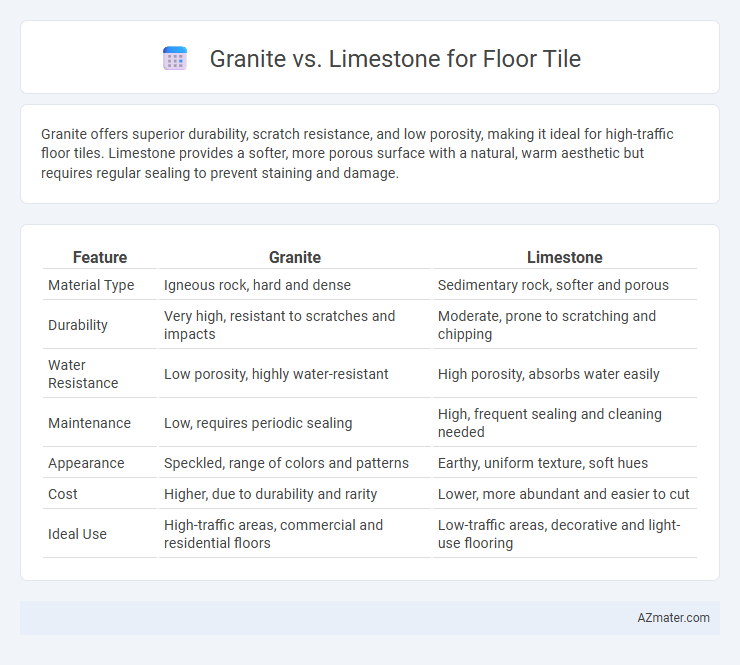Granite offers superior durability, scratch resistance, and low porosity, making it ideal for high-traffic floor tiles. Limestone provides a softer, more porous surface with a natural, warm aesthetic but requires regular sealing to prevent staining and damage.
Table of Comparison
| Feature | Granite | Limestone |
|---|---|---|
| Material Type | Igneous rock, hard and dense | Sedimentary rock, softer and porous |
| Durability | Very high, resistant to scratches and impacts | Moderate, prone to scratching and chipping |
| Water Resistance | Low porosity, highly water-resistant | High porosity, absorbs water easily |
| Maintenance | Low, requires periodic sealing | High, frequent sealing and cleaning needed |
| Appearance | Speckled, range of colors and patterns | Earthy, uniform texture, soft hues |
| Cost | Higher, due to durability and rarity | Lower, more abundant and easier to cut |
| Ideal Use | High-traffic areas, commercial and residential floors | Low-traffic areas, decorative and light-use flooring |
Introduction to Granite and Limestone Floor Tiles
Granite floor tiles are renowned for their exceptional durability, natural hardness, and resistance to scratches and stains, making them ideal for high-traffic areas. Limestone floor tiles offer a softer, more porous surface with unique, earthy tones and a matte finish that adds warmth and character to interior spaces. Both materials provide distinct aesthetic appeal and functionality, with granite emphasizing longevity and limestone highlighting natural texture and elegance.
Composition and Appearance Differences
Granite floor tiles are composed mainly of quartz, feldspar, and mica, giving them a dense, durable structure with a speckled, granular appearance and a polished finish that enhances color vibrancy. Limestone tiles consist primarily of calcium carbonate, featuring a softer, more porous texture with a smooth, matte surface marked by natural fossils and sediment patterns, offering a warm, earthy aesthetic. The mineral composition directly influences granite's resistance to scratches and stains, while limestone requires more maintenance due to its susceptibility to acids and abrasion.
Durability and Strength Comparison
Granite floor tiles offer superior durability and strength due to their natural igneous composition, making them highly resistant to scratches, cracks, and heavy foot traffic. Limestone, being a softer sedimentary rock, is more prone to wear, etching, and chipping, which limits its suitability for high-traffic areas. The high density and hardness of granite contribute to its longevity and low maintenance compared to the more porous and delicate nature of limestone tiles.
Water and Stain Resistance
Granite floor tiles offer superior water and stain resistance due to their dense, non-porous structure, making them ideal for high-moisture areas. Limestone tiles, being more porous, require regular sealing to prevent water absorption and staining. For maintenance ease and durability in wet environments, granite is the preferred choice over limestone.
Maintenance and Cleaning Requirements
Granite floor tiles require minimal maintenance due to their dense, non-porous surface, making them resistant to stains and scratches with simple regular cleaning using pH-neutral cleaners. Limestone tiles, being more porous and softer, demand frequent sealing to prevent moisture absorption and staining, along with gentle cleaning methods to avoid surface etching and damage. Both materials benefit from prompt spill cleanup, but granite's durability and lower upkeep make it more suitable for high-traffic areas requiring easy maintenance.
Slip Resistance and Safety
Granite floor tiles offer superior slip resistance due to their natural textured surface and high durability, making them a safer choice for high-traffic areas prone to moisture. Limestone, while aesthetically pleasing with its smooth and matte finish, tends to be more porous and slippery, especially when wet, requiring additional treatments or mats to enhance safety. For environments where slip resistance is critical, granite provides a more reliable, low-maintenance flooring solution compared to limestone.
Installation Process and Costs
Granite floor tiles require professional installation due to their hardness and weight, often necessitating specialized diamond blades and heavy-duty adhesive, which increases labor costs substantially compared to limestone. Limestone tiles are softer and more porous, allowing for easier cutting and installation with standard tools, resulting in lower labor expenses but higher maintenance costs due to sealing needs. The average installation cost for granite tiles ranges from $15 to $30 per square foot, while limestone installation typically falls between $10 and $20 per square foot, balancing initial outlay against long-term durability and upkeep.
Environmental Impact and Sustainability
Granite floor tiles originate from natural igneous rock known for its durability, requiring less frequent replacement and reducing long-term environmental waste. Limestone, a sedimentary rock, generally demands less energy during quarrying and processing, resulting in a smaller carbon footprint compared to granite. Both materials are recyclable, but limestone's softer nature may lead to shorter lifespan, influencing overall sustainability in flooring applications.
Best Applications and Room Suitability
Granite floor tiles offer exceptional durability and resistance to scratches and stains, making them ideal for high-traffic areas like kitchens, entryways, and commercial spaces. Limestone tiles provide a softer, more natural aesthetic perfect for low-traffic rooms such as bathrooms, living rooms, and bedrooms, where warmth and texture are prioritized. Choosing between granite and limestone depends on the balance of durability requirements and desired visual warmth for specific room applications.
Granite vs Limestone: Pros and Cons
Granite floor tiles offer exceptional durability, natural resistance to scratches, and low maintenance, making them ideal for high-traffic areas. Limestone tiles provide a softer, warmer aesthetic with a unique texture but are more porous and prone to staining, requiring regular sealing. Choosing between granite and limestone depends on prioritizing hardness and longevity versus natural beauty and a more delicate surface.

Infographic: Granite vs Limestone for Floor Tile
 azmater.com
azmater.com